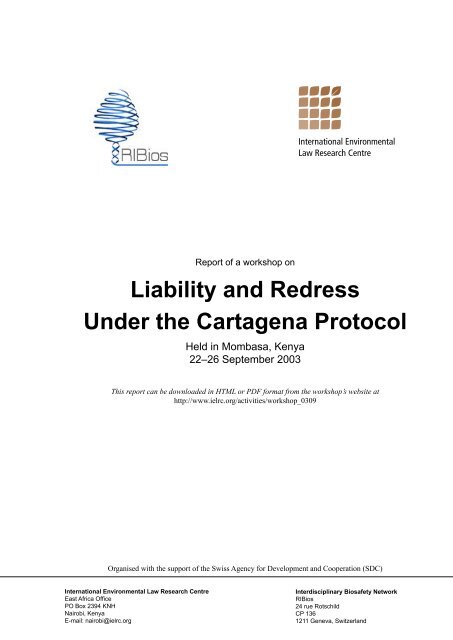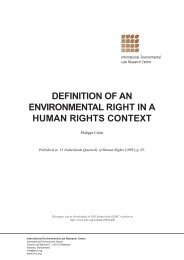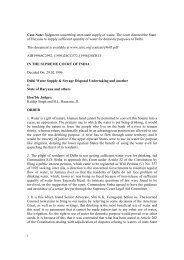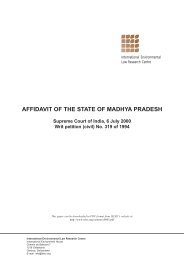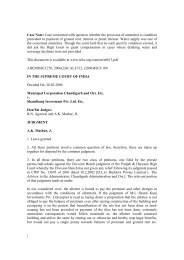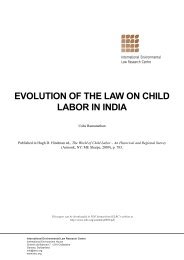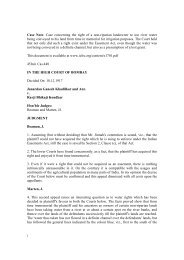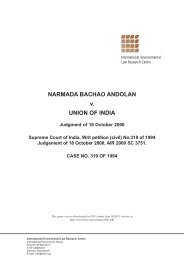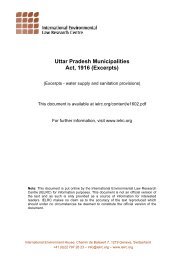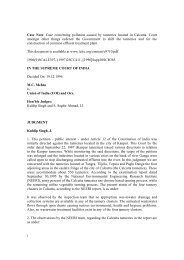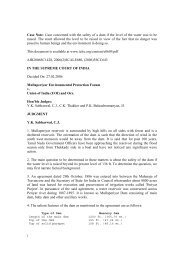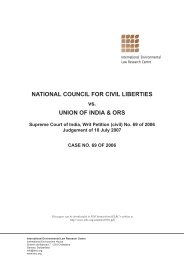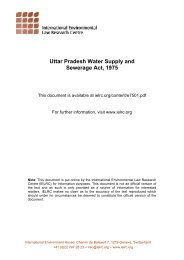Liability and Redress under the Cartagena Protocol - International ...
Liability and Redress under the Cartagena Protocol - International ...
Liability and Redress under the Cartagena Protocol - International ...
You also want an ePaper? Increase the reach of your titles
YUMPU automatically turns print PDFs into web optimized ePapers that Google loves.
I. BACKGROUNDOne of <strong>the</strong> areas of focus of <strong>the</strong> <strong>International</strong> Environmental Law Research Centre <strong>and</strong> <strong>the</strong> BiosafetyInterdisciplinary Network is biotechnology developments in <strong>the</strong> fields of agriculture <strong>and</strong> health. In principle,biotechnology can contribute to enhancing food security; reduce environmental pollution through reduction ofpesticide use <strong>and</strong> contribute to alleviation of poverty, improved nutrition; biodiversity management.Most of <strong>the</strong> Eastern African countries suffer from chronic food shortages <strong>and</strong> are among <strong>the</strong> poorest countriesin <strong>the</strong> world. They have low agricultural production, low fertility, pest infestation, poor agronomic practices<strong>and</strong> o<strong>the</strong>r non-physical factors some of which can be addressed through biotechnology. Biotechnology developmentcan only occur in <strong>the</strong> context of appropriate biotechnology <strong>and</strong> biosafety policies <strong>and</strong> strategies focusingon minimisation of risks <strong>and</strong> maximisation of benefits.The Convention on Biological Diversity provides a comprehensive <strong>and</strong> holistic approach to <strong>the</strong> conservationof biological diversity, <strong>the</strong> sustainable use of natural resources <strong>and</strong> <strong>the</strong> fair <strong>and</strong> equitable sharing of benefitsderiving from <strong>the</strong> use of genetic resources. The Convention also addresses biosafety. The concept of biosafetyrefers to <strong>the</strong> need to protect human health <strong>and</strong> <strong>the</strong> environment from <strong>the</strong> possible adverse effects of <strong>the</strong> productsof modern biotechnology. Articles 8(g) <strong>and</strong> 19, paragraph 3 seek to ensure <strong>the</strong> development of appropriateprocedures to enhance <strong>the</strong> safety of biotechnology in <strong>the</strong> context of <strong>the</strong> Convention’s overall goal of reducingall potential threats to biological diversity, taking also into account <strong>the</strong> risks to human health. Article 8(g) dealswith measures that Parties should take at national level.At its second meeting, held in November 1995, <strong>the</strong> Conference of <strong>the</strong> Parties to <strong>the</strong> Convention established anOpen-ended Ad Hoc Working Group on Biosafety to develop a draft protocol on biosafety. After years of negotiations,<strong>the</strong> <strong>Protocol</strong>, known as <strong>the</strong> <strong>Cartagena</strong> <strong>Protocol</strong> on Biosafety to <strong>the</strong> Convention on Biological Diversitywas finalized <strong>and</strong> adopted in Montreal on 29th January 2000 at <strong>the</strong> extraordinary meeting of <strong>the</strong> Conferenceof <strong>the</strong> Parties (COP). The protocol came into force on 11th September 2003. The stated objective of <strong>the</strong> protocolis that in accordance with <strong>the</strong> precautionary approach contained in Principle 15 of <strong>the</strong> Rio Declaration onEnvironment <strong>and</strong> Development, it seeks to contribute to ensuring an adequate level of protection in <strong>the</strong> fieldof <strong>the</strong> safe transfer, h<strong>and</strong>ling <strong>and</strong> use of living modified organisms (LMOs) resulting from modern biotechnologythat may have adverse effects on <strong>the</strong> conservation <strong>and</strong> sustainable of biological diversity, taking also intoaccount risks to human health. At Article 27 <strong>the</strong> protocol m<strong>and</strong>ates <strong>the</strong> COP serving as <strong>the</strong> protocol’s Meetingof <strong>the</strong> Parties (MOP) at its first meeting, to adopt a process with respect to <strong>the</strong> appropriate elaboration of internationalrules <strong>and</strong> procedures in <strong>the</strong> field of liability <strong>and</strong> redress.The following issues arise <strong>under</strong> Article 27:• What kinds of loss or damage should be compensated?• Who should pay for such loss or damage?• In what circumstances?• What remedies should be available for damage resulting from <strong>the</strong> transboundary movement ofLMOs?Is a specific international or national regime required to deal with <strong>the</strong> above issues <strong>and</strong> specifically setting outrules on liability <strong>and</strong> redress for damage resulting from <strong>the</strong> transboundary movement of LMOs?One of <strong>the</strong> greatest missing dimensions in <strong>the</strong> context of biotechnology development in <strong>the</strong> East African regionhas been <strong>the</strong> absence of laws <strong>and</strong> policies geared towards addressing liability <strong>and</strong> redress in bio-technology.The need for mechanisms to address liability <strong>and</strong> redress cannot be overemphasised in light of <strong>the</strong> stated regionalpolicy of embracing biotechnology. This dem<strong>and</strong>s overall direction <strong>and</strong> co-ordination of activities toensure provision of a guiding legal framework to address liability <strong>and</strong> redress. East African states are firmlyon-board <strong>the</strong> UNEP-GEF Biosafety Project <strong>and</strong> all have rudiments of a National Biotechnology Framework atdifferent stages of development. Biotechnology frameworks comprise of policy, legal <strong>and</strong> regulatory systemsto h<strong>and</strong>le requests, detailed risk assessment procedures, mechanisms for monitoring <strong>and</strong> inspections <strong>and</strong> stakeholderparticipation.1
2. Steps towards establishing a biosafety frameworkA national policy on <strong>the</strong> use of modern biotechnology should be established to guide decisions taken about<strong>the</strong> use of GMOs. The development of a national biosafety framework should follow extensive consultation toensure public awareness <strong>and</strong> input. Consultations within existing departments of environment, agriculture <strong>and</strong>health will ensure that <strong>the</strong> infrastructure is cross-sectoral efficient, cost-effective <strong>and</strong> capable of being implemented.An interim framework can be implemented using biosafety guidelines <strong>and</strong> an existing permit systemfor approvals while <strong>the</strong> legislation for <strong>the</strong> final framework is being modified or developed.Implementing <strong>the</strong> biosafety administration will be facilitated by capacity-building in both <strong>the</strong> h<strong>and</strong>ling ofGMO applications <strong>and</strong> biosafety review training. Reasonable fees charged to applicants can cover an efficientreview process.3. Components of an effective biosafety frameworkWhen faced with applications for use of GMOs, governments need to implement an effective biosafety frameworkto ensure a science-based review of <strong>the</strong> safety issues <strong>and</strong> a review of o<strong>the</strong>r factors important in makinga national decision. With hindsight, <strong>the</strong> following components are considered desirable in a national biosafetyframework:• A single entry point for applications, whe<strong>the</strong>r for GM plants, animals or micro-organisms;• An efficient biosafety administration for processing of applications (two people once applicationsreach about 40 a year);• A mechanism for ensuring confidential h<strong>and</strong>ling of commercial information;• Access to a trained pool of scientific expertise to independently assess <strong>the</strong> safety of each applicationon a case-by-case basis;• A call for public input into <strong>the</strong> application;• A single, transparent national decision-making body that can take into account <strong>the</strong> scientific riskassessment recommendations, <strong>the</strong> benefits, <strong>the</strong> public input <strong>and</strong> any national needs <strong>and</strong> prioritieswhen making decisions;• Development of a decision document that clarifies <strong>the</strong> safety issues of each GMO, <strong>the</strong> conditionsattached to specific releases <strong>and</strong> <strong>the</strong> reasons why decisions were made; <strong>and</strong>• Access to an inspectorate that can monitor whe<strong>the</strong>r release conditions are adhered to.a) Components of an interactive national biosafety framework• Acknowledge receipt of <strong>the</strong> application;• Assess what <strong>the</strong> applicant requires approval for <strong>and</strong> <strong>the</strong> nature of <strong>the</strong> GMO;• Select a group of scientists with <strong>the</strong> relevant expertise to review <strong>the</strong> safety of <strong>the</strong> proposal (about5 scientists are needed for each proposal, depending on what <strong>the</strong> GMO is <strong>and</strong> what it will do);• Publicise <strong>the</strong> application <strong>and</strong> call for public input;• Schedule a meeting for <strong>the</strong> scientific group to review <strong>the</strong> application <strong>and</strong> make recommendationsto <strong>the</strong> national decision making body regarding <strong>the</strong> activity, missing data, <strong>the</strong> possible risks <strong>and</strong>acceptable risk management procedures;• Where information is missing or clarification is needed, schedule a meeting with <strong>the</strong> applicant<strong>and</strong> <strong>the</strong> scientific review panel;• Call a decision-making meeting when <strong>the</strong> scientific <strong>and</strong> public input is available;• Once a decision had been made, prepare a decision document on <strong>the</strong> findings of <strong>the</strong> review <strong>and</strong>make this publicly available;• Notify <strong>the</strong> applicant <strong>and</strong> issue a permit where necessary; <strong>and</strong>• Schedule an inspection of <strong>the</strong> release site during <strong>and</strong> after <strong>the</strong> activity5
G. <strong>Liability</strong> <strong>and</strong> <strong>Redress</strong> ChallengesThere is a major challenge of linking GMO’s to liability <strong>and</strong> redress issues. There is uncertainty as to <strong>the</strong> impactof GMOs on <strong>the</strong> environment. Due to this uncertainty, proving causation of damage could be quite sticky,causation being a precursor to liability <strong>and</strong> redress. The uncertainty is coupled with <strong>the</strong> gap on knowledge on<strong>the</strong> interaction between GMOs <strong>and</strong> <strong>the</strong> environment. During <strong>the</strong> period of 1990 – 1995 only a few countrieshad adopted GM crop policies <strong>and</strong> even today <strong>the</strong> issues are not clearly developed.Ano<strong>the</strong>r h<strong>and</strong>icap identified is <strong>the</strong> definitional problem of damage. Issues of product <strong>and</strong> liability st<strong>and</strong>ards,identification of persons liable for damage <strong>and</strong> time limits for bringing claims were identified as challengesrequiring attention in <strong>the</strong> development of a liability <strong>and</strong> redress regime. One view was that to <strong>the</strong> best of <strong>the</strong>current knowledge, GM foods <strong>and</strong> crops are as safe as conventional ones because <strong>the</strong> approval process requiresmany tests over a period of many years. Nutritionists <strong>and</strong> o<strong>the</strong>r scientists, <strong>the</strong> workshop participants were told,do not know of any unresolved safety issues. That GM food <strong>and</strong> crops are being improved to provide betternutrition to consumers was a reason to call <strong>the</strong> liability <strong>and</strong> redress system into question.III. LIABILITY AND REDRESS IN INTERNATIONAL LAWA. State ResponsibilityIt’s a trite general principle of international law that states are responsible for activities within <strong>the</strong>ir territoriesthat cause transboundary damage. The locus classicus in international law jurisprudence is <strong>the</strong> Trail SmelterArbitration that concerned <strong>the</strong> pollution of Washington in <strong>the</strong> US by a smelter across <strong>the</strong> border in Canada.Indeed this principle was later encapsulated in <strong>the</strong> <strong>International</strong> Law Commission draft rules on state responsibilitywhere it is proposed at Article 1 that “every wrongful act of a state entails <strong>the</strong> international responsibilityof that state”.There are several defences available to states in avoiding responsibility. They include:• Acts of war;• Where acts complained of are wholly caused by a third party with intent to cause damage;• Discontinue wrongful conduct;• Guarantees of non-repetition;• Full reparation for injury caused; <strong>and</strong>• Prevent repetition <strong>and</strong> specify future conduct (Trail Smelter case)B. Civil <strong>Liability</strong>There are various schemes <strong>and</strong> treaties that govern <strong>the</strong> conduct of international relations. They include:1. Nuclear energy schemes principlesUnder nuclear energy schemes, liability is absolute. <strong>Liability</strong> is channelled exclusively to <strong>the</strong> operator of anuclear installation or ship. Limitations may be placed on <strong>the</strong> amount of compensation payable <strong>and</strong> <strong>the</strong> duration.Payment is up to a prescribed limit supported by compulsory insurance or security held by <strong>the</strong> operator<strong>and</strong> guaranteed by <strong>the</strong> state.6
2. The Council of Europe Convention on Civil <strong>Liability</strong> for Damage Resulting fromActivities Dangerous to <strong>the</strong> Environment, 1993This Convention was negotiated with a view to ensuring adequate compensation for damage resulting fromactivities dangerous to <strong>the</strong> environment (Art. 1). Dangerous activity was defined to include GMOs which, as aresult of <strong>the</strong> properties of <strong>the</strong> organisms, pose a significant risk to man, <strong>the</strong> environment or property (Art. 2).Damage was defined to include loss of life, personal injury, loss or damage by impairment of <strong>the</strong> environment(limited to costs of measures of reinstatement), cost of preventive measures (Art. 7)3. Limitations of liability schemes in public international lawThere is very limited case law reported. Indeed, <strong>the</strong> Trail Smelter Arbitration still blazes <strong>the</strong> trail as <strong>the</strong> onlyarbitral resolution touching on state responsibility. Case law is uncommon as states prefer resolving disputesthrough negotiations. Consequently, <strong>the</strong>re has been limited development of principles relating to liability (<strong>and</strong>limited focus on environment). It is worth noting that state responsibility is concerned with state to state obligationssince it is only States that are actors on <strong>the</strong> international scene. Private individual concerns can only bearticulated internationally through States as <strong>the</strong>y are not recognised as actors on <strong>the</strong> international level save for<strong>the</strong> internationally recognised non-state actors.Increasingly, emphasis in international environmental law is being laid on preventive measures as an alternative.O<strong>the</strong>r schemes have emerged to supplement <strong>and</strong> streng<strong>the</strong>n customary international law liability provisions.These include <strong>the</strong> Polluter Pays Principle (PPP). O<strong>the</strong>r treaties such as <strong>the</strong> Basel Convention, at Article4.3, have criminalised some activities.4. GMOs: liability issues in international lawStates are to take all appropriate measures to prevent significant harm (cf. ILC liability draft Art 3). Preventivemeasures include assessment of overall advantages of social, economic <strong>and</strong> technical character as well as assessmentof means to prevent such harm or restore <strong>the</strong> environment (cf. ILC liability draft, Art. 10). There canbe liability for any environmental damage (cf. 1992 oil pollution, Art. III).To prevent damage, disincentives for <strong>the</strong> introduction of GMOs through <strong>the</strong> use of biosafety clauses in intellectualproperty laws can be introduced as it has been done, for instance, in Thail<strong>and</strong>.5. “Reverse” liability of farmers<strong>Liability</strong> may attach to farmers simply because <strong>the</strong>y own l<strong>and</strong> on which grows GMOs that cause damage. Thereis need to establish a linkage between real property <strong>and</strong> intellectual property. It is also critical to link biosafetyto patents in that patent holders be made liable for <strong>the</strong>ir product’s biosafety.6. DiscussionAs a general principle of customary international law states are liable for acts that have transboundary effectsoccurring within <strong>the</strong>ir territories. However <strong>the</strong> nitty gritty of state responsibility are not developed.7
IV. THE COMMON LAW APPROACH TO LIABILITY ANDREDRESSA. The Role of Common Law in Dealing with <strong>Liability</strong> <strong>and</strong> <strong>Redress</strong> forBiotechnology ActivitiesCommon law comprises rules of customary law which have been recognised by English courts. The commonlaw system is built on precedents <strong>and</strong> centres on individual decisions; it has built up its principles by gradualgrowth from case to case. In East Africa, <strong>the</strong> common law is a colonial legacy. Colonial governments soughtto extend to English settlers <strong>the</strong> same rights <strong>and</strong> privileges <strong>the</strong>y enjoyed in Engl<strong>and</strong>. The common law was <strong>and</strong>still remains a significant part of this package of rights <strong>and</strong> privileges. Common law was adopted in <strong>the</strong> coloniesin <strong>the</strong> East African region through a reception clause which, in Kenya’s case is, for instance, <strong>the</strong> JudicatureAct, Chapter 8 of <strong>the</strong> Laws of Kenya. It provides that courts are to apply “<strong>the</strong> substances of <strong>the</strong> common law”but only to <strong>the</strong> extent that Kenya’s circumstances <strong>and</strong> its inhabitants permit. Indeed, <strong>the</strong> common law constitutesa significant source of law for Kenya, since it is <strong>the</strong> applicable law in <strong>the</strong> absence of legislation. Ug<strong>and</strong>ahas equivalent legislative provisions domesticating <strong>the</strong> common law in light of <strong>the</strong> common East Africancolonial legacy.The common law arm that deals with liability <strong>and</strong> redress is <strong>the</strong> law of tort. Torts are defined as civil wrongs.A civil wrong is said to be a breach of legal duty which affects <strong>the</strong> interest of an individual to a degree which<strong>the</strong> law regards as sufficient to allow that individual to complain on <strong>the</strong>ir own account. There are three tortsthat were discussed at <strong>the</strong> workshop <strong>and</strong> found to be relevant in biotechnology debate of liability <strong>and</strong> redress.These are <strong>the</strong> tort of negligence, nuisance <strong>and</strong> <strong>the</strong> rule in Ryl<strong>and</strong>s Vs Fletcher.1. NegligenceNegligence protects interests in physical <strong>and</strong> mental health, reputation, property interests, economic relationships<strong>and</strong> public rights. To establish negligence <strong>the</strong> following ingredients have to be proven:• Existence of what in law is “a duty of care situation”, namely, a situation in which <strong>the</strong> law attachedliability to carelessness;• Secondly <strong>the</strong>re has to be breach of <strong>the</strong> duty of care by <strong>the</strong> defendant, that is, failure to measure upto <strong>the</strong> st<strong>and</strong>ard set by <strong>the</strong> law;• A casual connection between <strong>the</strong> defendant’s careless conduct <strong>and</strong> <strong>the</strong> complained of damage hasto be established; <strong>and</strong>• The damage has to have been foreseeable, that is, not so unforeseeable as to be too remote.a) ReasonablenessThe defendant will be in breach of <strong>the</strong> duty of care if his or her conduct falls below <strong>the</strong> st<strong>and</strong>ard required by <strong>the</strong>law. The applicable st<strong>and</strong>ard is that of a reasonable <strong>and</strong> prudent person. But that leaves an important questionunanswered: what level of care will be reasonable in any particular situation?The common law has provided some useful guidance: First, <strong>the</strong> st<strong>and</strong>ard of care expected of <strong>the</strong> reasonableperson is generally objective. It does not take into account <strong>the</strong> weaknesses or inexperience of <strong>the</strong> defendant inquestion. Second, <strong>the</strong> common law requires courts to do a cost benefit analysis: Is it reasonable (or fair) for<strong>the</strong> defendant to bear <strong>the</strong> cost of a particular form of precautionary conduct in light of <strong>the</strong> level of protection<strong>and</strong> benefit it will confer on <strong>the</strong> plaintiff <strong>and</strong> o<strong>the</strong>rs? Third, community values will be taken into consideration.Courts will be influenced by <strong>the</strong> evidence of practice within <strong>the</strong> community. But this is to be balanced against<strong>the</strong> reasonable expectations of <strong>the</strong> community.8
) ForeseeabilityThe foreseeability test is not one of <strong>the</strong> actual foresights of <strong>the</strong> defendant. Instead, it is what <strong>the</strong> court determinesto be foreseeable, after reviewing <strong>the</strong> evidence <strong>and</strong> trying to do justice. Why is this a good test? It is flexible<strong>and</strong> leaves a large element of discretion to courts. This is good because it enables courts to raise st<strong>and</strong>ardsof expected behaviour by insisting on better precautions being taken in advance. Thus it enables justice to bedone according to <strong>the</strong> merits of each individual case.c) Negligence <strong>and</strong> <strong>the</strong> <strong>Protocol</strong>The transboundary movement of LMOs could have a number of effects on ecosystems such as <strong>the</strong> crossing ofintroduced traits; herbicide resistance into wild relatives of <strong>the</strong> LMO; toxic effects produced on o<strong>the</strong>r organismsin <strong>the</strong> environment or on humans or livestock affected via <strong>the</strong> food chain. A number of questions arise:• Who should be liable in <strong>the</strong>se situations? Manufacturers, exporters, operators, exporting states,states of origin?• Who owes a duty of care?• What constitutes damage? Any degree of change of biodiversity?• Thresholds? Is <strong>the</strong> damage foreseeable?• Will “state of <strong>the</strong> art” defence be appropriate?• Should liability be strict? So that it does not matter that <strong>the</strong> defendant was not negligent.These questions cannot effectively be addressed in <strong>the</strong> abstract. They are best dealt with in <strong>the</strong> context of specificcases. This makes <strong>the</strong> tort of negligence a suitable regime for addressing <strong>the</strong>m. The tort of negligence can<strong>the</strong>refore effectively deal with <strong>the</strong> liability of manufacturers, exporters <strong>and</strong> operators. In <strong>the</strong>se cases, it wouldbe relatively easy for courts to determine whe<strong>the</strong>r <strong>the</strong>re are duties of care situations. Indeed, torts of such acharacter would be actionable if committed in Kenya, for instance, notwithst<strong>and</strong>ing <strong>the</strong>ir lack of basis forfounding an action in o<strong>the</strong>r jurisdictions. The idea of imposing liability on states for <strong>the</strong> acts of private entitiesis bound to be problematic. The State Action Doctrine is a doctrine of customary international law that seeks toestablish, in accordance with international law, actions or omissions attributable to <strong>the</strong> state as an internationalactor. The basic principle is that for acts or omissions to be attributed to <strong>the</strong> state at international level, <strong>the</strong>yhave to have been <strong>under</strong>taken by members or an organisation or agency of <strong>the</strong> state. Attribution, even in instancesinvolving recognised state organs, is problematic where <strong>the</strong>y have exceeded <strong>the</strong>ir competence or actedin outright contravention of municipal law.The tests of reasonableness <strong>and</strong> foreseeability make <strong>the</strong> tort of negligence a potentially effective tool for liability<strong>and</strong> redress for h<strong>and</strong>ling, transfer <strong>and</strong> use of LMOs. In particular, two features of LMOs make <strong>the</strong> tortunknown of negligence an appropriate liability <strong>and</strong> redress regime: first, <strong>the</strong> effects of LMOs are still largelyunknown so that any liability regime would be speculative at best. By contrast, a statutory liability regime isunlikely to anticipate all <strong>the</strong> possible harmful effects that might be generated by <strong>the</strong> manufacture <strong>and</strong> utilisationof LMOs. Second, LMOs may be dangerous <strong>and</strong> <strong>the</strong>refore a need for precaution arises.In applying <strong>the</strong>se tests, <strong>the</strong> courts should be guided by <strong>the</strong> provisions of relevant international instruments,including <strong>the</strong> <strong>Cartagena</strong> <strong>Protocol</strong>, which constitutes an expression of “reasonable expectations” of <strong>the</strong> internationalcommunity. For instance, <strong>the</strong> statement of <strong>the</strong> precautionary principle follows from an internationalrecognition of <strong>the</strong> need for <strong>and</strong> legitimacy of applying precaution in a situation of scientific uncertainty about<strong>the</strong> potential risks associated with particular uses of biotechnology. Whe<strong>the</strong>r or not <strong>the</strong>re is a duty of care situationwill depend on <strong>the</strong> level of compliance with <strong>the</strong> <strong>Protocol</strong>, e.g., whe<strong>the</strong>r <strong>the</strong>re was exporter notification orrisk assessment.Corruption would no doubt compound <strong>the</strong> case, but <strong>the</strong> level of liability will depend on <strong>the</strong> extent to whichone complied with requirements of <strong>the</strong> <strong>Protocol</strong>. Local courts need <strong>the</strong>refore not wait for <strong>the</strong>ir governments todomesticate international treaties. Where appropriate, <strong>the</strong>y should treat treaties as expressions of <strong>the</strong> reasonableexpectations of <strong>the</strong> people within <strong>the</strong>ir jurisdiction. Indeed some national constitutions such as <strong>the</strong> SouthAfrican one m<strong>and</strong>ate national courts to seek guidance from relevant international treaties.9
d) Drawbacks of negligence principlesThe concept of negligence presents a difficulty in enforcing liability <strong>and</strong> redress for biotechnology activitiesbecause of <strong>the</strong> locus st<strong>and</strong>i requirements <strong>and</strong> <strong>the</strong> time limits. On <strong>the</strong> one h<strong>and</strong>, <strong>the</strong> plaintiff has to prove that<strong>the</strong> defendant, over <strong>and</strong> above <strong>the</strong> general public, owed him a duty of care. On <strong>the</strong> o<strong>the</strong>r h<strong>and</strong>, being a tort, anaction accruing from it must statutorily be filed within 3 years from <strong>the</strong> date of occurrence. The requirement offoreseeability was also identified as one of <strong>the</strong> major issues that make <strong>the</strong> concept of negligence inappropriatewhile attaching liability <strong>and</strong> redress to activities involving GMOs. This is associated with lack of knowledge<strong>and</strong> <strong>the</strong>refore foreseeability.For <strong>the</strong> common law negligence principles to provide an effective liability <strong>and</strong> redress regime for biotechnologyactivities, <strong>the</strong>re needs to be training courses organised for policy makers, judges <strong>and</strong> <strong>the</strong> general publicabout <strong>the</strong> nature <strong>and</strong> potential adverse effects of LMOs.2. Rule in Ryl<strong>and</strong>s vs FletcherThis rule applies to anything brought on l<strong>and</strong> in <strong>the</strong> course of its non-natural use, that is likely to do mischiefon escape. Damage <strong>and</strong> escape need not be reasonably foreseeable. This concept was found to be weak becauseit contemplates natural users of l<strong>and</strong> thus limiting its application to industrial <strong>and</strong> pollution activity on l<strong>and</strong>. Italso alienates damage caused by GMOs since GMOs by <strong>the</strong>ir nature are not “things” on l<strong>and</strong>. In case <strong>the</strong> conceptis to be utilised in apportioning <strong>and</strong> attaching liability, <strong>the</strong>n it will only be used in instances where <strong>the</strong>rewas a deliberate act of introducing GMOs on l<strong>and</strong>. Overall, it offers weak protection to litigants.3. NuisanceIt was defined as an act or omission, which is an interference with, disturbance of or annoyance of a personin enjoyment or exercise of a right belonging to him as a member of <strong>the</strong> public, his ownership/occupation orenjoyment of his l<strong>and</strong>, easement or profit or o<strong>the</strong>r use connected with l<strong>and</strong>. This tort was found to be weak <strong>and</strong>inappropriate since it is only utilised when <strong>the</strong> damage extends to a neighbour or interferes with <strong>the</strong>ir comfortableenjoyment of l<strong>and</strong>.B. Disadvantages of Common Law in GMO <strong>Liability</strong> <strong>and</strong> <strong>Redress</strong>As outlined above, <strong>the</strong> common law may offer a suitable liability <strong>and</strong> redress regime but it has a number oflimitations. First, <strong>the</strong> common law’s conception of rights is quite narrow. A broader conception of rights willthus be necessary if <strong>the</strong> law of torts is to provide an effective liability <strong>and</strong> redress regime for <strong>the</strong> use of LMOs.It is encouraging that courts throughout <strong>the</strong> Commonwealth have over <strong>the</strong> years relaxed <strong>the</strong>ir locus st<strong>and</strong>i requirements.But <strong>the</strong>re is still a need to retrain judges so that <strong>the</strong>y may see beyond common law rights. Classactions would be a good way to go but <strong>the</strong>re is limited experience where <strong>the</strong> loss or damage is by impairmentor to <strong>the</strong> environment.The common law works best where <strong>the</strong>re is a good flow of information. Unfortunately, <strong>the</strong> international intellectualproperty regime has restricted it. For example, <strong>the</strong> protection of processes through patents limits <strong>the</strong>flow of technical information about biotechnology products. As a result, <strong>the</strong> amount of information availableto operators, regulators, courts <strong>and</strong> <strong>the</strong> general public is not sufficient. In <strong>the</strong> context of <strong>the</strong> tort of negligence,this makes it difficult for courts to effectively apply <strong>the</strong> tests of foreseeability <strong>and</strong> reasonableness. Additionally,common law systems require effective law reporting. Unfortunately, law reporting has not been given <strong>the</strong> appropriateattention in developing countries, such as Kenya <strong>and</strong> Ug<strong>and</strong>a.In conclusion, while <strong>the</strong>re is need to adopt new technology crucial for development especially in modernisationof agriculture, it is imperative to have a system in place to assess <strong>and</strong> manage risks present in biotechnology.In this regard, East African states should participate in <strong>the</strong> <strong>Cartagena</strong> <strong>Protocol</strong> discussions on liability <strong>and</strong>redress.10
V. STATUTORY APPROACH TO LIABILITY AND REDRESS INKENYA, UGANDA AND SWITZERLANDIn this section we will look at <strong>the</strong> approaches that Kenya, Ug<strong>and</strong>a <strong>and</strong> Switzerl<strong>and</strong> have taken to <strong>the</strong> liabilityissue. The Swiss example is interesting since it represents <strong>the</strong> only country that currently has a specific law onliability for biotechnology.A. KenyaKenya ratified <strong>the</strong> <strong>Protocol</strong> in January 2000 <strong>and</strong> <strong>the</strong> <strong>Protocol</strong> came into force on 11 September, 2003.Under <strong>the</strong><strong>Protocol</strong> process however <strong>the</strong> negotiations for an effective system of liability <strong>and</strong> redress with regard to GMOs<strong>and</strong> <strong>the</strong>ir derivatives is still a subject of debate. O<strong>the</strong>r issues yet to be agreed on relate to labelling <strong>and</strong> traceability.The uncertainty regarding <strong>the</strong>se issues seems to support strongly <strong>the</strong> precautionary approach in• Regulating <strong>the</strong> transit of GMOs• Restrictimg of GMOs to contained use in laboratories• Subjecting all GMO for use in pharmaceuticals to Advance Informed Agreement(AIA)Kenya supports <strong>the</strong> precautionary principle in its environmental protection <strong>and</strong> sustainable development policies.The principle in accordance with <strong>the</strong> Kenyan law is that:Where <strong>the</strong>re are threats of damage to <strong>the</strong> environment, whe<strong>the</strong>r serious or irreversible, lack offull scientific certainty shall not be used as a reason for postponing cost-effective measures toprevent environmental degradation.The need to protect human health <strong>and</strong> <strong>the</strong> environment from <strong>the</strong> possible adverse effects of products of modernbiotechnology <strong>and</strong> <strong>the</strong> great potential that modern biotechnology has in <strong>the</strong> promotion of human-well being infood, agriculture <strong>and</strong> health care are <strong>the</strong> two sides of <strong>the</strong> same coin. Nobody is clear as of now how to address<strong>the</strong>se two aspects of modern biotechnology. The confusion <strong>the</strong>refore must be addressed by all stakeholders sothat <strong>the</strong> policy makers as well as <strong>the</strong> law makers will have a foot to st<strong>and</strong> on once <strong>the</strong>y make <strong>the</strong>ir decisionwhich, ei<strong>the</strong>r way, could have far wider repercussions on <strong>the</strong> survival of <strong>the</strong> Nation.The <strong>Protocol</strong> in its preamble recognises <strong>the</strong> limited capabilities of many countries, particularly developingones, to cope with <strong>the</strong> nature <strong>and</strong> scale of known <strong>and</strong> potential risks associated with living modified organisms<strong>and</strong> for this reason <strong>the</strong> polluter pay principle comes in h<strong>and</strong>y. The Kenyan law stipulates that <strong>the</strong> cost ofcleaning up any element of <strong>the</strong> environment damaged by pollution, compensating victims of pollution, cost ofbeneficial uses lost as a result of an act of pollution <strong>and</strong> o<strong>the</strong>r costs that are connected with or incidental to <strong>the</strong>foregoing, is to be paid or borne by <strong>the</strong> person convicted of pollution <strong>under</strong> this act or any o<strong>the</strong>r applicable law.Pollution is defined as any direct or indirect alteration of <strong>the</strong> physical, <strong>the</strong>rmal, chemical, biological, or radioactiveproperties of any part of <strong>the</strong> environment by discharging, emitting, or depositing wastes so as to affectany beneficial use adversely, to cause a condition which is hazardous or potentially hazardous to public health,safety or welfare, or to animals, birds, wildlife, fish or aquatic life, or to plants or to cause contravention of anycondition, limitation, or restriction which is subject to a licence <strong>under</strong> this act.The adverse effect of LMOs may not be considered as pollution in <strong>the</strong> strict application of <strong>the</strong> above definitionbut <strong>the</strong> concept is still applicable when it comes to <strong>the</strong> introduction of LMOs into <strong>the</strong> environment althoughmeant for beneficial use but turning out to be harmful. The question is who pays for <strong>the</strong> consequences? TheKenyan law seems to favour <strong>the</strong> position that <strong>the</strong> producer or manufacturer of such LMOs pays <strong>and</strong> this mayrequire ensuring in our laws that <strong>the</strong> manufacturer or exporter of such LMO has adequately <strong>under</strong>written <strong>the</strong>risk through insurance to cover any such eventualities.11
a product of a farmer. The time limitation within which one could bring a suit is thirty years for any loss ordamage that may accrue. The statute’s important elements are compensation for environmental loss, optionalfinancial guarantees <strong>and</strong> <strong>the</strong> facilitation of <strong>the</strong> burden of proof.VI. CONCLUSION AND THE WAY FORWARDA. General ScopeIn developing a liability <strong>and</strong> redress regime for biotechnology activities, <strong>the</strong>re is need to distinguish betweencivil <strong>and</strong> penal liability. Patent liability should also be considered as a separate issue. Some of <strong>the</strong> issues tobe considered here are: <strong>the</strong> obligation to provide for compensation for damage caused by activities whichpose potential risks to persons property <strong>and</strong> <strong>the</strong> environment; liability for environmental contamination (OilPollution Convention, Trail smelter case, Basel <strong>Protocol</strong>); <strong>Liability</strong> for food chain contamination (<strong>under</strong> Swisslaw covered by general principles of law <strong>and</strong> in Kenya <strong>the</strong> common law tort of negligence would apply);<strong>Liability</strong> for lawful commercialisation or release; The concept of strict liability (Ryl<strong>and</strong>s v. Fletcher); <strong>Liability</strong>for unlawful commercialisation or release; Penal liability; Civil liability as far as <strong>the</strong> liable person is solvent;Whe<strong>the</strong>r absolute liability would be appropriate; <strong>Liability</strong> for controlled or uncontrolled spread of transgenicorganisms – strict liability; <strong>and</strong> patent <strong>Liability</strong> - Breach of Patent Law requires civil liability as one of <strong>the</strong>possible consequences.These issues have to be considered within <strong>the</strong> purview of international instruments that <strong>the</strong>East African countries have ratified or are participating in such as: CBD, <strong>Cartagena</strong> <strong>Protocol</strong>Codex alimentarius, (Bases of global st<strong>and</strong>ards in food trade); WTO agreement on sanitary <strong>and</strong> phytosanitarymeasures; TRIPS; <strong>and</strong> joint efforts of FAO; WHO, UNEP to deal with health <strong>and</strong> environmental risks associatedwith biotechnology.There is also need to look at <strong>the</strong> national instruments that are relevant. In Kenya, <strong>the</strong>se include:Constitution: guarantees <strong>the</strong> right to life; EMCA: a right to clean <strong>and</strong> healthy environment,obligation to protect environment; Provides penal <strong>and</strong> civil sanctions for infringement.St<strong>and</strong>ards Act; Regulations <strong>and</strong> guidelines for biosafety <strong>and</strong> biotechnology for Kenya (NCST) 1998; DraftConstitution Draft Biosafety Bill <strong>and</strong> <strong>the</strong> Draft Biotechnology <strong>and</strong> Biosafety Policy. In Ug<strong>and</strong>a <strong>the</strong>y include:The Constitution, 1995 which provides for <strong>the</strong> protection of <strong>the</strong> environment: of importance for <strong>the</strong> controlof hazardous LMOs; The National Environmental Statute, an umbrella statute giving a framework withwhich sectoral laws are to conform: The Agricultural, Seed <strong>and</strong> Plant statute which offer protection, regulation<strong>and</strong> control of plant breeding <strong>and</strong> variety release, import, quality assurance of seeds <strong>and</strong> plant materials; <strong>the</strong>Plant Protection Act; The Ug<strong>and</strong>a National Bureau of St<strong>and</strong>ards Act; The Ug<strong>and</strong>a National Council of science<strong>and</strong> technology statute; <strong>and</strong> <strong>the</strong> Ug<strong>and</strong>a National Council of Science <strong>and</strong> Technology, Biosafety Regulations1999.13
B. Tenets of a <strong>Liability</strong> <strong>and</strong> <strong>Redress</strong> System for BiosafetyThe following points arose from <strong>the</strong> debates <strong>and</strong> discussions in <strong>the</strong> workshop.1. Relevance/ Limitations of Existing <strong>Liability</strong> Regimesa) Common lawRelevant torts include: negligence, nuisance <strong>and</strong> <strong>the</strong> rule in Ryl<strong>and</strong>s v. Fletcher. The limitations of <strong>the</strong>se includelimited law reporting; <strong>the</strong> onerous evidentiary burdens which are not easy to discharge.b) Statutory lawRelevant laws include framework environmental laws which embody such principles as <strong>the</strong> precautionary<strong>and</strong> polluter pays principles; right to clean & healthy environment <strong>and</strong> public participation. The limitationsinclude liability for adverse effects of GMOs not envisaged in current laws on public health <strong>and</strong> food safetye.g., Kenya’s Food <strong>and</strong> Drugs Act only covers liability for “fitness for human consumption”. But GMOs maybe fit for human consumption <strong>and</strong> still have adverse effects. Fur<strong>the</strong>r, <strong>the</strong>re are defects in our judicial systems<strong>and</strong> laws of civil procedure <strong>and</strong> cases may not be decided on merits <strong>and</strong> <strong>the</strong> evidentiary burden is not easy todischarge.Causation is also difficult because isolating causal factors where <strong>the</strong>re are multiple causes is not easy. There areinadequate human resources in terms of numbers <strong>and</strong> knowledge base. There are very few people to articulateissues in courts <strong>and</strong> to decide.We can borrow from o<strong>the</strong>r systems such as <strong>the</strong> Swiss law but we need to adapt <strong>the</strong>m to suit our socio-economiccultural <strong>and</strong> political circumstances.c) State responsibilityRelevant international law includes <strong>the</strong> Trail Smelter arbitration for damage originating from outside a state’sboundary. Customary international law principles on state responsibility are also relevant <strong>and</strong> specific treatiesrelating to specific issues. The limitations here include limited case law with few pertinent decisions; liabilityis only state-to-state <strong>and</strong> no redress is available for private actors.d) Civil responsibility regimes in international lawUnder <strong>the</strong> nuclear energy schemes, liability is absolute except in instances of war <strong>and</strong> natural disasters. <strong>Liability</strong>is exclusively channelled to <strong>the</strong> operator of <strong>the</strong> nuclear installation or ship. Limitations to liability may beplaced on <strong>the</strong> amount payable <strong>and</strong> <strong>the</strong> duration. It is noteworthy that payments have prescribed limits supportedby compulsory insurance or security held by <strong>the</strong> operator <strong>and</strong> guaranteed by <strong>the</strong> state.The Council of Europe Convention on Civil <strong>Liability</strong> for Damage Resulting from Activities Dangerous to <strong>the</strong>Environment of 1993 aims at ensuring adequate compensation for damage resulting from activities dangerousto <strong>the</strong> environment (Art. 1). Dangerous activities are defined to include GMOs, which as a result of <strong>the</strong>ir propertiespose a significant risk for man, <strong>the</strong> environment or property (Art.2).Just like in state responsibility, limitations in this scheme include limited case law; limited development ofprinciples relating to liability (<strong>and</strong> limited focus on environment); <strong>the</strong>re is also an upsurge in emphasis of internationalenvironmental law on preventive measures.14
2. Fault based/ strict/ absolute liability?Fault Based: One must prove intention/ negligence of defendant;Strict: No need to show intention/ negligence of defendant but it must be proved, for instance that <strong>the</strong> productwas defective;Absolute: Defendant has no defence open to <strong>the</strong>m such as act of God defence for hazardous activities.Strict liability was favoured above fault-based <strong>and</strong> strict. This was especially in <strong>the</strong> food regime practiceswhere it is difficult to prove intention <strong>and</strong> negligence <strong>and</strong> <strong>the</strong>re is need to ensure potential defendants take alldue precautions. Fur<strong>the</strong>r <strong>the</strong> liability should be joint <strong>and</strong> several to ensure that <strong>the</strong>re is fair allocation of responsibilitybetween defendants.3. Definition of liability regimeThe <strong>Liability</strong> regime should be comprehensive including: Civil; Penal; State liability – through joint <strong>and</strong> severalliability. The state should be responsible for public actors. An international civil liability scheme should beestablished to cover activities of multinational corporations (MNCs). MNCs should contribute to <strong>the</strong> liabilityscheme.4. Channelling of liabilityThere was no agreement on whe<strong>the</strong>r liability should be channelled to farmers. They however agreed that <strong>the</strong>seed producer, marketer/ trader <strong>and</strong> any entity not acting appropriately should be liable.5. Type of compensationCompensation should include financial/pecuniary aspects in <strong>the</strong> form of damages/fines <strong>and</strong> also restoration/reinstatementof <strong>the</strong> environment to <strong>the</strong> “best extent possible” as provided for in Kenya’s EnvironmentManagement <strong>and</strong> Coordination Act.6. Who should be compensated?A distinction should be drawn between damage to humans where rights holders should be recompensed <strong>and</strong>damage to <strong>the</strong> environment where government agencies should use funds in <strong>the</strong> public interest. In instanceswhere <strong>the</strong> government has sanctioned <strong>the</strong> activity, <strong>the</strong>re are potential conflicts of interest <strong>and</strong> funds could bemanaged by a different agency of government.7. Time limitsThe time limits should be determined through a scientific approach. With regard to impacts on human health,physiological effects manifest <strong>the</strong>mselves within five years generally <strong>and</strong> shorter time frames of about ten yearsshould be adopted. For impacts on <strong>the</strong> environment/ecosystems, longer time frames of thirty years should beadopted.8. Procedure to prosecuteA mixed system should be adopted with special technical courts <strong>and</strong> courts of first instance to hear evidence.Appeals should be addressed through <strong>the</strong> ordinary court process. Overall, <strong>the</strong>re is need to educate scientistson how <strong>the</strong> legal process works especially with regard to <strong>the</strong> question of evidence in technical matters <strong>and</strong> <strong>the</strong>avoidance of frivolous law suits. There is also need to build capacity for public interest litigation in biosafetywith <strong>the</strong> aim of protecting <strong>the</strong> interests of unorganized groups such as farmers <strong>and</strong> consumers against MNCs.15
C. The Way ForwardSt<strong>and</strong>ard/product liability is relevant so long as <strong>the</strong>re is evidence of proof of causation. The limits of st<strong>and</strong>ard<strong>and</strong> product liability are that one pays for causing damage. It is important to have st<strong>and</strong>ard liability in keepingwith NES <strong>and</strong> EMCA position of polluter pays. However, Proving causation is a limitation <strong>and</strong> <strong>the</strong>re is aninformation gap which makes it difficult to establish a rigorous nexus between damage <strong>and</strong> causation. There isneed for scientific expertise in proving damage <strong>and</strong> judicial officers need to be trained to appreciate <strong>the</strong> technical<strong>and</strong> scientific concepts <strong>and</strong> terms.In st<strong>and</strong>ard liability <strong>the</strong>re are time limits of three years within which to bring an action. The costs of litigationare also high <strong>and</strong> access to accurate information may not readily avail information. The lack of resources canalso hamper bringing in expert opinion.With product liability, it attaches onto <strong>the</strong> final product <strong>and</strong> <strong>the</strong> point of use. If <strong>the</strong> product causes damage <strong>the</strong>n<strong>the</strong> user may be liable if damage is caused by his use of <strong>the</strong> product <strong>and</strong> where <strong>the</strong> user acts against prescribedinstructions on <strong>the</strong> manual of use. The manufacturer will be at fault if <strong>the</strong> product is defective <strong>and</strong> damage occursbecause of that defect. <strong>Liability</strong> covers product not process, thus previous input is not held accountable.The time limitation of three years is still a h<strong>and</strong>icap <strong>and</strong> <strong>the</strong>re may be need to redefine <strong>the</strong> term manufacturerto make it applicable to GMOs. In case of a wrong usage of <strong>the</strong> GMO product, <strong>the</strong> user will be sued jointly <strong>and</strong>severally with <strong>the</strong> manufacturer. Lack of legal representation may lead to liability attaching to a user notwithst<strong>and</strong>ingabsence of causation.The advantages of GMO specific liability is that one can tailor <strong>the</strong> regime for time limitation to <strong>the</strong> traceabilityof GMOs. It will also help to evaluate environmental damage <strong>and</strong> control <strong>the</strong> illegal introduction of GMOs. Thedisadvantage of GMO specific liability is that causation is hard to establish.1. Role of scientific data in decision making.Decision-making should be founded on specific data. Where <strong>the</strong>re is divergence in scientific data, <strong>the</strong>re areproblems. Bio-ethics should also be used to inform <strong>the</strong> process <strong>and</strong> public awareness <strong>and</strong> cultural issues shouldalso inform <strong>the</strong> process.2. Role of insuranceThe risk caused by GM is insurable <strong>and</strong> risk coverage should be done by way of policy plans. There shouldalso be sensitisation of <strong>the</strong> public about <strong>the</strong> risk. On <strong>the</strong> issue of who is to take out <strong>the</strong> insurance cover, eachentity in <strong>the</strong> GMO activity line has to take cover according to <strong>the</strong> magnitude of risk, with <strong>the</strong> manufacturer as<strong>the</strong> highest risk taker. Farmers who work with GMOs also need to take insurance cover, as well as consumers.The cover for consumers should however not be m<strong>and</strong>atory. The insurance premiums will be used to financecompensation <strong>and</strong> should be determined by actuarial scientists.For state actors, <strong>the</strong> state should be held liable for allowing activities adversely affecting <strong>the</strong> environment/human/animal/plan<strong>the</strong>alth. Courts should be involved in adjudicating claims. Insurance companies will alsorequire state investigators in determining liability.Government <strong>under</strong>writes its researchers to be held responsible.As an alternative to insurance, alternative financial guarantee options should also be explored. The governmentshould provide <strong>the</strong>se guarantees. Private-sector actors being <strong>the</strong> primary beneficiaries should take out m<strong>and</strong>atoryinsurance while in <strong>the</strong> case of public /private sector partnerships, guarantees should also be provided byway of an endowment fund.16
3. <strong>Liability</strong> <strong>and</strong> consumer choiceThe consumer has a right to choose. Lack of disclosure by <strong>the</strong> manufacturer to <strong>the</strong> consumer should occasionliability. Fur<strong>the</strong>r, lack of information that will enable a consumer to make an informed choice should occasionliability whe<strong>the</strong>r <strong>the</strong>re is damage or not.4. What qualifies as GMO for liability <strong>and</strong> redress?All GMOs <strong>and</strong> <strong>the</strong>ir derivatives should trigger liability <strong>and</strong> redress.5. Role of diverse regulators in liability <strong>and</strong> redressa) Kenya Bureau of St<strong>and</strong>ards (KEBS)• Develop st<strong>and</strong>ards for regulating <strong>and</strong> products;• GMO product specifications;• Codes of practice/guidelines for h<strong>and</strong>ling GMO processes; <strong>and</strong>• Testing methods.b) Kenya Plant Health Inspectorate Service (KEPHIS)• Examining <strong>the</strong> safety of plants & plant products before entry, for purposes of preventing diseases& pests;• KEPHIS should be held liable for allowing any harmful products especially disease & pest infectedGMO; <strong>and</strong>• They need to inspect & monitor GMO activity <strong>and</strong> should terminate license in case of risk.Failure should attract institutional responsibility.c) National Council for Science & Technology (NCST)• The National Biosafety Committee is a clearinghouse that h<strong>and</strong>les <strong>and</strong> approves GMO work on<strong>the</strong> basis of sufficient data;• Approval should be on <strong>the</strong> basis of GMO safety; <strong>and</strong>• Institutional responsibility, thus liability, for permitting harmful GMOs.d) National Environmental Management Authority (NEMA)• After commercialisation NEMA needs to do an audit <strong>and</strong> provide data in case of damage, in collaborationwith lead agencies <strong>and</strong> when persons seek redress; <strong>and</strong>• NEMA should conduct inspections <strong>and</strong> monitoring; liability should result if <strong>the</strong>y fail.e) Department of Veterinary Services• H<strong>and</strong>les animals <strong>and</strong> feeds of animal origin (bone meal, blood meal);• Needs to take preventative measures against introduction of disease <strong>and</strong> pest infected GMO;• Needs to continuously monitor & inspect <strong>the</strong> effect of <strong>the</strong> products;• They offer data instances where claimants seek redress; <strong>and</strong>• They take institutional responsibility for failure to conduct inspections & monitoring.17
e) Pest Control Products Board• Regulates, controls <strong>and</strong> registers pest control products in Kenya looking at appropriateness ofusage;• The GMO pesticide approved <strong>and</strong> registered that is harmful should occasion liability; <strong>and</strong>• They should also provide data <strong>and</strong> technical information to claimants seeking redress.f) <strong>Liability</strong> <strong>and</strong> redress in National Biosafety Frameworks• NBF needs to capture clearly <strong>the</strong> need for liability <strong>and</strong> redress systems; <strong>and</strong>• There is need for a specialized tribunal to adjudicate on GMO liability <strong>and</strong> redress issues.Nairobi, 5 November 2003.18
Annex: List of ParticipantsMigai AKECHEmail: migai@yahoo.comDoris AKOLEmail: dorisakol@hotmail.comRoselyn AMADIEmail: roselynamadi@hotmail.comJuerg BALLYEmail: juerg.bally@ buwal.admin.chLilian Anne CHEROTICHEmail: lilichero2001@yahoo.comPhilippe CULLETEmail: pcullet@ielrc.orgEdwin NGURE KAMERIEmail: kadugee@yahoo.comJavason KAMUGISHAEmail: jkamugisha@muklaw.ac.ugPatricia KAMERI MBOTEEmail: pkameri-mbote@ielrc.orgJoseph KIMARU KEERUEmail: jkeeru@kebs.orgGladys NJERI MAINAEmail: kephis@nbnet.co.keLois MURAGURIEmail: L.muraguri@cgiar.orgFrancis NANG’AYOEmail: biotech@skyweb.co.keElvin NYUKURIEmail: E.nyukuri@cgiar.orgCecilia NZAUEmail: nzaucecilia@yahoo.comAnne OBUYAEmail: Awino25@yahoo.comSamuel J. OCHIENGEmail: cin@insightkenya.comProf. James OPIYO OCHANDAEmail: Joch<strong>and</strong>a@uonbi.ac.keAlbert SIMIYU MURAMBIEmail: asimiyu@ielrc.orgMoses M. SHAHAEmail: moses.388ke@mail.comHarrison MACHARIA KAMAUEmail: ncstnbo@insightkenya.comFor more information on <strong>the</strong> Workshop <strong>and</strong> <strong>the</strong> participants,please visit <strong>the</strong> Workshop’s website athttp://www.ielrc.org/activities/workshop_030919
www.ribios.chwww.ielrc.org


